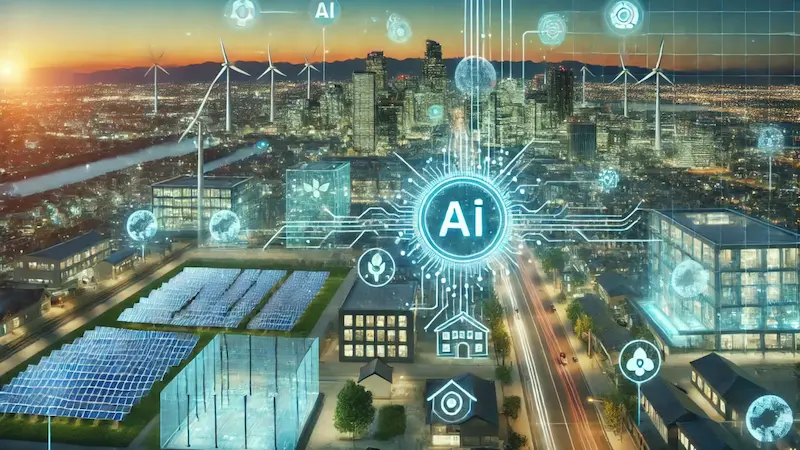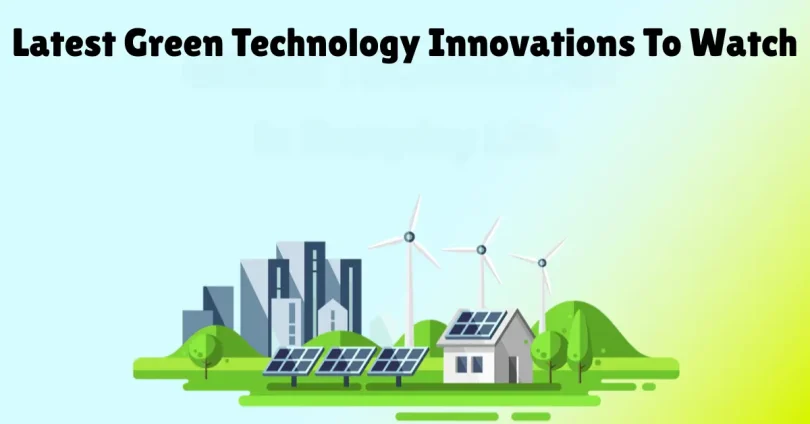With climate change accelerating, the need for real solutions—not just buzzwords—has never been greater. The challenge? Sorting through countless eco-friendly ideas to find the ones that actually work at scale. That’s where keeping an eye on the latest green technology innovations to watch becomes essential.
Just like in the tech world where only a few devices truly shape our lives, green tech has its own “game-changers.” Some fade away, while others win global awards, secure funding, and start making an impact today.
That’s why we explored projects recognized by the Earthshot Prize, SET100, and CleanTech Breakthrough Awards in 2024 and 2025. These aren’t futuristic concepts—they’re real solutions already cleaning our air, powering our homes, and rethinking sustainability.
Let’s dive into 15 of the most exciting green tech innovations shaping our future.
1. Carbon Capture and Utilization 2.0

Carbon capture isn’t new, but the latest wave is smarter and more purposeful. Instead of just storing CO₂ underground, startups are transforming it into valuable products. For example, CarbonCure Technologies injects captured CO₂ into concrete, making it stronger while locking carbon away permanently. Similarly, companies like LanzaTech are converting emissions into jet fuel and textiles. This turns carbon from a liability into a resource—climate action that pays for itself.
2. Direct Ocean Carbon Removal
The ocean already absorbs about 25% of human-caused CO₂, but new innovations are supercharging this natural process. Startups are experimenting with mineralization techniques that lock carbon in seawater for centuries, and large-scale seaweed farms that capture CO₂ while providing sustainable food and biofuel. These methods not only fight emissions but also improve ocean health, making them a two-for-one solution to climate change and ecosystem restoration.
3. Next-Gen Green Hydrogen
Hydrogen has long been called the “fuel of the future,” but producing it cleanly was too expensive—until now. Breakthroughs in solar-powered electrolysis and low-cost catalysts are bringing down the cost of green hydrogen production. This matters because hydrogen can power heavy trucks, cargo ships, and even factories—industries that are otherwise difficult to decarbonize. Countries like Germany, Japan, and Australia are already investing billions to scale green hydrogen infrastructure.
You may also like to read this:
Best Upcoming AI Tools For Productivity In 2025 Guide
Top 8 Blockchain Applications Beyond Cryptocurrency Today
Future Applications of Quantum Computing Explained Guide
How The Impact of 5G on Gadgets Is Changing Technology
4. Smart Renewable Energy Storage
Solar and wind are excellent renewable sources, but their intermittency has always been a challenge. The latest solutions include gravity batteries (which store energy by lifting and lowering heavy weights), liquid metal batteries (long-lasting and safe for the grid), and AI-powered storage systems that predict demand and release energy efficiently. These innovations ensure renewable energy can be delivered reliably, even when the sun isn’t shining or the wind isn’t blowing.
5. Vertical Farming 3.0
Agriculture consumes enormous amounts of land and water, but vertical farming is rewriting the rules. In these futuristic farms, crops grow in stacked layers indoors using hydroponics and LED lighting. Companies like AeroFarms and Plenty have shown they can grow lettuce, strawberries, and even grains with 95% less water and no pesticides. Plus, by setting up near cities, vertical farms cut down on transport emissions, making our food system both greener and more resilient.
6. Plant-Based Plastics at Scale
Plastic pollution is everywhere—from oceans to our food. New bioplastics, made from materials like corn, sugarcane, and algae, are stepping in as sustainable alternatives. Unlike older bioplastics, the latest versions are durable, flexible, and industrially scalable, meaning big brands can actually adopt them. Imagine getting your online order packaged in plastic that decomposes safely instead of polluting the environment—that’s the promise of this innovation.
7. Water-from-Air Technology
Access to clean water is a growing global challenge. Enter atmospheric water generators (AWGs), which pull drinking water directly from humidity in the air. Powered by solar energy, these devices can produce liters of clean water per day. Startups like Watergen are already rolling out units in drought-hit regions, offering an affordable and sustainable way to ensure safe drinking water.
8. Smart Grids and AI Energy Management

Our electricity grids are going digital. Smart grids use AI and data analytics to balance supply and demand in real time, preventing blackouts and reducing waste. On a household level, smart meters and AI-driven systems help people cut energy use (and costs) without lifting a finger. For example, if your washing machine knows when renewable energy is cheapest, it runs then—saving you money and helping the planet.
9. Solar Paint and Transparent Solar Panels
Imagine a world where every building, window, and surface generates energy. Solar paint uses nanoparticles to absorb sunlight and turn it into power, while transparent solar panels can be integrated into glass windows and facades. This means offices, homes, and even skyscrapers could become mini power plants, massively increasing clean energy production without taking up extra space.
10. Waste-to-Energy Innovations
Instead of letting trash pile up in landfills, innovators are turning it into fuel. Modern waste-to-energy plants can convert organic waste into biofuels and biogas while also generating electricity from non-recyclable materials. Countries like Sweden have already adopted this model at scale, reducing landfill use dramatically while creating clean energy. It’s a smart way to tackle two problems—waste and energy—at once.
11. Electric Aviation and Sustainable Fuels
Aviation accounts for about 2.5% of global emissions, but green aviation is taking off. Electric planes are being developed for short-haul flights, while sustainable aviation fuels (SAF) made from waste oils, algae, and captured carbon are already being blended with traditional jet fuel. Companies like ZeroAvia are pioneering hydrogen-powered aircraft, showing that even the skies can be decarbonized.
12. Algae-Based Biofuels
Algae grows incredibly fast, absorbs CO₂, and produces oil that can be refined into fuel. Several startups are now producing cost-effective algae biofuels that could one day replace diesel, gasoline, and jet fuel. Unlike crops like corn or soy, algae doesn’t need farmland or fresh water, making it one of the most sustainable biofuel sources available.
13. Smart Building Materials
Buildings generate nearly 40% of emissions worldwide, but new smart materials are helping. Self-healing concrete repairs cracks automatically, extending lifespans. Carbon-absorbing bricks store emissions while strengthening over time. And dynamic glass adjusts tint depending on sunlight, reducing the need for heating and cooling. These upgrades reduce costs for builders and energy bills for homeowners.
14. Regenerative Agriculture
Farming doesn’t have to harm the earth—in fact, it can heal it. Regenerative agriculture focuses on rebuilding soil health, restoring biodiversity, and capturing carbon. Practices like cover cropping, no-till farming, and rotational grazing are proving to make soil richer and more resilient. With the help of AI-driven soil sensors, farmers can now track carbon capture and crop health in real time, scaling these practices globally.
15. AI-Powered Climate Forecasting
Finally, AI is giving us supercharged climate prediction tools. Traditional models often miss local details, but AI-powered forecasting can now predict floods, droughts, and wildfires with stunning accuracy. For governments and communities, this means better preparation, fewer lives lost, and billions saved in disaster recovery costs.
Why These Green Technology Innovations Matter
Each of these breakthroughs isn’t just “green” for the sake of it—they’re practical, scalable, and already changing industries. The latest green technology innovations to watch go beyond buzzwords. They’re about reducing emissions, rethinking waste, protecting natural resources, and making sustainability profitable.
Think about it: concrete made from carbon, houses painted with solar paint, farms stacked like skyscrapers—this isn’t sci-fi anymore, it’s real. And the best part? Many of these innovations are already attracting big investments, meaning they could soon be part of our everyday lives.
Final Thoughts
The climate crisis demands urgency, but it’s also inspiring some of the most exciting solutions in history. From smart grids to algae fuels, these 15 latest green technology innovations to watch are showing us that sustainability isn’t just survival—it’s a smarter, cleaner, and more resilient way to thrive.
If you’re an entrepreneur, investor, policymaker, or eco-conscious consumer, these aren’t just trends to follow. They’re opportunities to act, support, and adopt solutions that will define the future. The world is moving toward green technology faster than ever—and the future is already here.
FAQs
1. What are the latest green technology innovations to watch in 2025?
Some of the biggest innovations include carbon capture 2.0, renewable hydrogen, AI-powered smart grids, algae-based biofuels, solar paint, and electric aviation. These technologies are transforming how we produce energy, reduce emissions, and live sustainably.
2. Why are green technology innovations important?
They help tackle climate change, pollution, and resource scarcity while driving new opportunities in clean energy, jobs, and sustainable industries. Green tech is not just about protecting the planet—it’s also about building a resilient economy.
3. Which industries benefit most from green technology?
Key industries include energy, agriculture, transportation, construction, and manufacturing. For example, renewable energy innovations power industries sustainably, while green building materials reduce construction’s carbon footprint.
4. How does AI improve green technology?
AI enables smarter energy grids, predictive climate modeling, waste management, and precision farming. It helps optimize resources, cut emissions, and increase efficiency in green projects worldwide.
5. Can individuals adopt green technology in daily life?
Yes! On a personal level, people can use solar panels, energy-efficient appliances, electric vehicles, water-saving devices, and smart home tech to reduce their environmental footprint.






